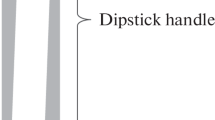Abstract
An adaptation for clinical purposes of a radial immune hemolysis test for the detection of the heat-labile (LT) enterotoxin of the enterotoxigenic Escherichia coli is described. The results correlated well with those from Vero cell assay and the passive immune hemolysis test. Because the test is easy, relatively cheap, and as sensitive as other standard procedures, for LT detection, it is particularly suitable for less-equipped laboratories. Also, a large number ofE. coli strains may be examined daily by this technique.
Similar content being viewed by others
References
Brill BM, Wasilauskas BL, Richardson SH (1979) Adaptation of the staphylococcal coagglutination technique for detection of heat-labile enterotoxin ofEscherichia coli. J Clin Microbiol 9:49–55
Castro AFP, Serafim MB, Gomes JA, Gatti MS (1980) Improvements in the passive immune hemolysis test for assaying enterotoxigenicEscherichia coli. J Clin Microbiol 12:714–717
Clements JD, Finkelstein RA (1978) Immunological cross-reactivity between a heat-labile enterotoxin (s) ofEscherichia coli and subunits ofVibrio cholerae enterotoxin. Infect Immun 21:1036–1039
Clements JD, Finkelstein RA (1978) Demonstration of shared and unique immunological determinants in enterotoxins fromVibrio cholerae andEscherichia coli. Infect Immun 22:709–713
Donta ST (1974) Neutralization of cholera enterotoxin induced steroidogenesis by specific antibody. J Infect Dis 129:284–288
Donta ST, Moon HW, Whipp SC (1974) Detection of heat-labileEscherichia coli enterotoxin with the use of adrenal cells in tissue culture. Science 183:334–336
Evans DG, Evans DJ, Gorbach SL (1973) Identification of enterotoxigenicEscherichia coli and serum antitoxin activity by the vascular permeability factor assay. Infect Immun 8:731–735
Evans DJ, Evans DG, Gorbach SL (1973) Production of vascular permeability factor by enterotoxigenicEscherichia coli isolated from man. Infect Immun 8:725–730
Evants DJ, Evans DG, Gorbach SL (1974) Polymixin B induced relase of low-molecular-weight heat-labile enterotoxin fromEscherichia coli. Infect Immun 10:1010–1017
Evans DJ, Evans DG (1977) Direct serological assay for the heat-labile enterotoxin ofEscherichia coli, using passive immune hemolysis. Infect Immun 16:604–609
Greenberg HB, Sack DA, Rodriguez W, Sack RB, Wyatt RG, Kalica AR, Horswood RS, Chanock RM, Kapikian AZ (1977) Microtiter solid-phase radioimmunoassay for detection ofEscherichia coli heat-labile enterotoxin. Infect Immun 17:541–545
Guerrant RL, Brunton LL, Schnaitman TC, Rebhun LI, Gilman AG (1974) Cyclic adenosine monophosphate and alteration of Chinese hamster ovary cell morphology: a rapid, sensitive in vitro assay for the enterotoxin ofVibrio cholerae andEscherichia coli. Infect Immun 10:320–327
Gyles CL (1974) Immunological study of the heat-labile enterotoxins ofEscherichia coli andVibrio cholerae. Infect Immun 9:564–570
Holmgren J (1973) Comparison of the tissue receptor forVibrio cholerae andEscherichia coli enterotoxin by means of gangliosides and natural cholera toxoid. Infect Immun 8:851–859
Holmgren J, Soderlind O, Wadstrom T (1973) Cross-reactivity between heat labile enterotoxins ofVibrio cholerae andEscherichia coli in neutralization tests in rabbit ileum and skin. Acta Pathol Microbiol Scan Sect B 81:757–762
Honda T, Taga S, Takeda Y, Miwatani T (1981) Modified Elek test for detection of heat-labile enterotoxin of enterotoxigenicEscherichia coli. J Clin Microbiol 13:1–5
Kudoh Y, Yamada S, Matsushita S, Ohta R, Tsuno M, Muraoka T, Ohtomo N, Ohashi M (1979) Detection of heat-labile enterotoxin ofEscherichia coli by reversed passive hemagglutination test with specific immunoglobulin against cholera toxin. In: Takeya K, Zinnaka Y (eds) Proceedings of the 14th Joint Conference of the U.S-Japan Cooperative Medical Science Program, Cholera Panel, Toho University, Tokyo, pp 266–273
Moon HW, Whipp SC, Engstron GW, Beatz AL (1970) Response of the rabbit ileal loop to cell free products fromEscherichia coli enteropathogenic for swine. J Infect Dis 121:182–187
Mundell DH, Anselmo CR, Wishnow RM (1976) Factors influencing heat-labileEscherichia coli enterotoxin activity. Infect Immun 14:383–388
Sack DA, Sack RB (1975) Test for enterotoxigenicEscherichia coli using Y1 adrenal cells in miniculture. Infect Immun 11:334–336
Sack RB, Gorbach SL, Banwell JG, Jacobs B, Chatterjee BD, Mitra RC (1971) EnterotoxigenicEscherichia coli isolated from patients with severe cholera-like disease. J Infect Dis 123:378–385
Serafim MB, Pestana de Castro AF, Reis LR, Trabulsi LR (1979) Passive immune hemolysis for detection of heat-labile enterotoxin produced byEscherichia coli isolated from different sources. Infect Immun 24:606–610
Serafim MB, Pestana de Castro AF, Leonardo MB, Monteiro AR (1981) A single radial immune hemolysis (SRIH) test for the detection of thermolabile (LT) entero toxin ofEscherichia coli. J Clin Microbiol (in press)
Smith HW, Gyles CL (1970) The relationship between two apparently different enterotoxins produced by enteropathogenic strains ofEscherichia coli of porcine origin. J Med Microbiol 3:387–401
Smith HW, Halls S (1968) The transmissible nature of the genetic factor inEscherichia coli that controls enterotoxin production. J Gen Microbiol 32:319–334
Speirs JI, Tavric S, Konowalchuk J (1977) Assay ofEscherichia coli heat-labile enterotoxin with Vero cells. Infect Immun 16:617–622
Svennerholm AM, Holmgren J (1978) Identification ofEscherichia coli heat-labile enterotoxin by means of a ganglioside immunosorbent assay (Gml-ELISA) procedure. Curr Microbiol 1:19–23
Tsukamoto T, Konoshita Y, Taga S, Takeda Y, Miwatani T (1980) Value of passive immune hemolysis for detection of heat-labile enterotoxin produced by enterotoxigenicEscherichia coli. J Clin Microbiol 12:768–771
Author information
Authors and Affiliations
Rights and permissions
About this article
Cite this article
Yano, T., Oliveira, M.S., Fontes, C.F. et al. Detection of heat-labile (LT) enterotoxin of enterotoxigenicEscherichia coli by the radial immune hemolysis test: a modification for clinical use. Med Microbiol Immunol 171, 171–178 (1982). https://doi.org/10.1007/BF02123625
Received:
Issue Date:
DOI: https://doi.org/10.1007/BF02123625




